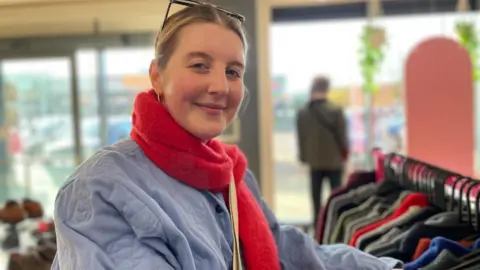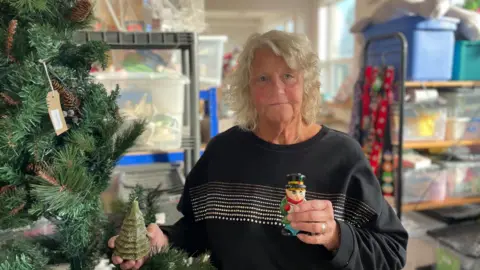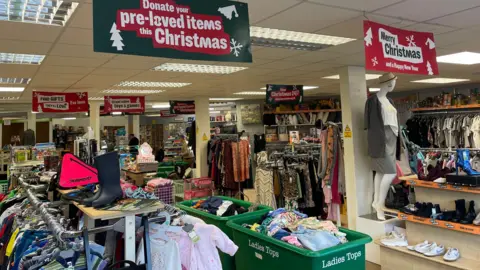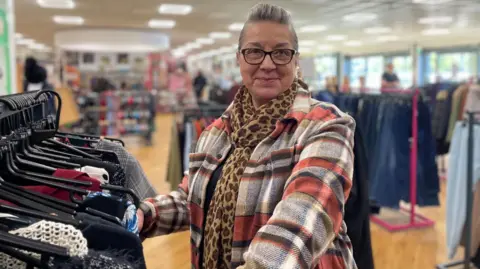Versace bag for £15: Why Christmas shoppers are choosing charity shops
 BBC/Simon Thake
BBC/Simon ThakeGail Wragg stands and surveys the scene unfolding around her.
She’s at the centre of a sea of bin bags, shelving units packed with electrical equipment and also has the small matter of 800 artificial Christmas trees to sort.
Like other retail workers, Gail’s shop store room is deep in the throes of getting stock ready for the festive rush.
But rather than a retailer looking to make big profits to satisfy shareholders, Gail runs a Barnardo’s charity shop aimed at raising cash to fund the organisation’s work.
She’s been in the charity industry for more than 40 years and says demand is higher than ever as people can no longer to afford to buy new after a period of rapidly rising food, heating and housing costs.
“Although footfall has gone up this year, donations have gone down,” she explains.
“People come here because of the cost of living but they’ve also stopped donating because of the cost of living.”
For customers, there are plenty of bargains on offer – with £15 covering the cost of a Versace handbag and even a TV for some canny shoppers.
 BBC/Simon Thake
BBC/Simon ThakeThe increase in demand is a view echoed by Robin Osterley, chief executive of the Charity Retail Association (CRA).
The body is the industry voice for charity shops and says 2023 saw “record growth” in sales.
He says members have already reported “strong” shopping habits in the run-up to Christmas at the end of a year where steady sales growth of 2.9% had previously been charted.
“People are increasingly wanting to spend less money for Christmas, but also have a warm feeling that they’re contributing to good causes and are having an impact,” he adds.
That feeling is evident out on the shop floor, where customer Doug Hodgson is eyeing up a row of kitchen paraphernalia.
He says a shopping list is not needed – just an open mind.
“Nobody comes here to buy a fondue set – but, who knows, I might leave with one,” he smiles.
‘Don’t tell anyone’
Last year Doug wanted to surprise his partner so he came here to the shop on Abbeydale Road in Sheffield, South Yorkshire, to get some “Christmas sparkle”.
“She was poorly so I wanted to cheer her up. When she was in the hairdressers I legged it around here and bought a little tree and pink and silver baubles. She loves pink!
“I set it all up in our bedsit for when she got back. She cried. It made her Christmas,” the 57-year-old remembers.
Gail, 66, says a reduction in the stigma around charity shops has also helped to drive demand.
“In the 1980s my children said ‘don’t tell anyone you work for a charity’. They hated it!
“They were embarrassed and worried in case people thought their clothes were from there but it’s trendy now,” she says.
According to a survey by Oxfam, about a quarter of people will buy children’s gifts to be unwrapped on Christmas morning from charity shops.
They suggest books, toys and board games as potential lures for parents hoping to help Santa keep a few extra pennies in his pocket.
 BBC/Simon Thake
BBC/Simon ThakeAcross the city, those in the Sense charity shop in Hillsborough Barracks can combine a hunt for vintage items with fresh produce at the Morrisons supermarket next door.
Flo Patterson is flicking through a rack of men’s winter jumpers.
She moved to Sheffield six months ago after studying textiles and design in Manchester. She now works as a marketing and sales manager in textiles and sustainability.
Flo says she and friends all use charity shops.
“It is an easy way of making sustainable choices. There’s too much second-hand clothing.
“Fast fashion often means polyester items that never biodegrades. You can find better quality older items.”
Assistant store manager Chiara Hunter says they have been “crazy busy” in 2024.
“Increasingly you see celebrities charity shopping and I think the power of social media has really helped,” she adds.
 BBC/Simon Thake
BBC/Simon ThakeFlo has already started her Christmas shopping.
“I like the idea of finding gems. I found a Versace handbag for £15 once. The jumpers are always better quality too,” she adds.
Charlotte Deering can often be found in charity shops near her home in Cheshire.
The 28-year-old uses social media under the name of themoneyferret to highlight thrifty gifts and cut-price finds.
She cites a £15 TV for her daughter’s bedroom as her best purchase.
“I couldn’t believe it, I nearly skipped out of the shop I was that pleased.
“I’ve actually kept the price tag on to remind me what a bargain it is,” she beams.
 Charlotte Deering
Charlotte DeeringThis Christmas, Charlotte, who started her online journey after a period of homelessness and the traumatic birth of Maeve, now aged four, has set herself a £5 budget for new festive decorations.
“I got a little toadstool bauble for 50p, a rocking horse one which I will give to my mum,” she says.
“My nana and grandad, who have passed away, used to have a rocking horse so I thought that would be a lovely memory for her tree.”
She has also picked up a bag of Playmobil characters for a few pounds to replicate the firm’s more costly Advent calendar for Maeve.
“There was no way I was paying £25.
“I’ve created my own which looks great. I’ve stuck all the numbers on the wrapped-up figures so she has to pick it out and find the numbers herself so it all helps with her maths too which is a bonus.”
Charlotte says she finds it quicker to get around charity shops rather than a traditional high street search and cites them as a “win-win”, adding: “You’re donating to charity and saving money, so everyone benefits.”
 Zara Canfield
Zara CanfieldZara Canfield, 31, from Banbury, began using second-hand shops in 2019 after taking part in Oxfam’s Second Hand September.
The month-long campaign calls on people to tackle the environmental pollution caused by the fashion industry by buying previously used items.
She hasn’t bought any new clothes since then.
This week she bought £30 of Christmas goods from the charity’s store in Oxford.
“I came out with a massive bag full of bits and bobs. I got hair accessories, pots and jars to fill with presents, pyjamas for my sister which are brand new and all sorts of other stuff.”
She said she had been able to get festive party outfits from charity shops – last year she picked up an elf dress for £3.99 and a sweater for her sausage dog Minnie.
Her family and friends are now used to her second-hand present buying and she says they “didn’t bat an eyelid. There’s no snobbery at all”.
Zara, who is engaged to partner Olly, says she also plans on buying her wedding dress second-hand.
 BBC/Simon Thake
BBC/Simon ThakeBack in Sheffield, the paint has just finished drying on the St Luke’s Hospice charity department store.
The new outlet, which raises money to help care for terminally ill adults, is the organisation’s biggest.
Jennie Booth stands in the 7,000sq ft stock room and says new sites like this shake off the image of charity shops having “little old ladies doing their knitting behind the counter”.
“We get phenomenal donations,” she tells me.
“Most of our Christmas stock comes in January when people realise they have more presents than they need; designer items, shoes and hand bags.”
Jennie says the charity needs £14m a year to run – and they have to raise £10m of that themselves.
“We have to be smart and have a commercial business head on,” she states.
She says charity shopping is popular with many now and consumers are increasingly looking to do something worthwhile with their unwanted items.
In the shop Denise Berham, 63, is looking for Christmas gifts.
She’s been a committed charity shopper for years – finding a Louis Vuitton handbag and purse in one more than a decade ago.
Today, her sights are set on slightly less luxurious items.
“I love to get old books, retro games that you can’t find.
“Mousetrap is the one I want – I’d be happy if I found that.”







